
Over The Horizon Radars : Situational Awareness Beyond The Horizon

As part of the United States of America (US) strategy for ‘containment’ of its perceived strategic rivals in the Western Pacific, the US Department of Defense announced on 28 December 2022, that it had awarded a US$ 118.4 Million contract for construction of reinforced concrete pads/foundations on the Pacific Island of Palau. These structures are for installation of a Tactical Mobile Over-the-Horizon (OTH) Radar (TACMOR) for the US Air Force (USAF), to enhance long-range air/maritime domain situational awareness for US/allied forces in the region. The OTH radar (OTHR) is to be effective by 2026.
As is well known, most radars work on the principle of line-of-sight (LOS) propagation of Electromagnetic (EM) waves, with ranges limited by this principle to the visible horizon. While ground-based LOS radars can detect airborne platforms/vectors at relatively greater ranges, range to ground targets is limited by the visible horizon as radar signals travel with line-of-sight propagation. As airborne technology for long-range engagement improved in accuracy/lethality/response times over the last millennium, an urgent need was felt by armed forces to improve radar technology for provision of early-warning (EW) and enhanced situational awareness at far greater ranges. Apropos, this would necessitate detection ranges beyond the visible horizon and would therefore require to incorporate technology that could ‘see’ beyond LOS (BLOS). These operational requirements gave rise to the technology of the OTHR.
Among the milestones in development of OTHR technology, the erstwhile Soviet Union were the first to develop an OTH system in 1949 called Veyer. The first fully operational OTHR development was a joint US Air Force-British Air Force system known as Cobra Mist, constructed in the late 1960s/early 1970s. This OTHR could detect aircraft over the Western Soviet Union from its location in Southeastern England. One of the first OTHR for detection of Soviet ballistic missile launches was the Sugar Tree OTHR built by the US in the 1960s. Reverting to the Soviet Union, their next known successful project was the Duga-1 OTHR, which was operational from 1976 to 1989 on the Black Sea Coast and formed a part of the Soviet Union’s EW radar network for Missile Defence. With the advent of airborne platforms and satellites with EW capabilities, the armed forces of the world lost interest in OTHR systems. OTHR technology has however seen a resurgence in recent times due to the rising requirements of maritime reconnaissance/surveillance and long-range/ low-cost situational awareness.

MADRE OTHR: Source – media.defense.gov
What is the Principle and System Architecture of an OTHR?
OTHR, or beyond-the-horizon radar (BTHR), operate in the HF Band and use large antenna arrays to transmit EM waves. These waves are reflected in a chosen medium (ionosphere/ sea-air interface) to reach the target location and reflected back through the same medium for detection by the same/different antenna arrays. OTHR currently find use in surveillance/detection of long-range air/maritime targets, as an aid in maritime navigation by military ships and in anti-piracy/drug trafficking operations.
Since the maximum range of a conventional radar is limited by the earth’s horizon or its curvature, achievement of longer, beyond-radar-horizon(BRH) capability necessitates the use of a reflection/refraction medium, both for transmission of incident EM waves and reception of reflected waves from the target for detection. Since radio waves in the HF band can be reflected back to Earth by the electrically-charged ionospheric layer in the atmosphere (‘skip’ or ‘skywave’ propagation), or by the surface of the ocean, these frequencies are suitable for long-distance transmission/reception, even across intercontinental distances. Use of HF Band frequencies ensures that attenuation or loss of the transmitted signal is small, thereby retaining enough energy for reflection/ refraction back towards the Earth’s surface, at very large distances. The reflected signal from the target then follows the same route for reception by the OTHR receiver, either built into the same transmitter (monostatic) or a separate receiver unit (multistatic) for the purpose. Received radar signals are then analysed by a system computer to identify objects of relevance within the radar footprint. The OTHR can generate a 2D image of the target (comprising of the target’s latitude, longitude, speed and heading [direction of movement]). Due to this requirement of high reflectivity from the Earth’s surface towards the ionosphere at the point of transmission, there is often a requirement of installing wire mesh/reflective material mats upto a few Km from the transmitter antenna. Coupled with this is the fact that larger antennae give higher gain. Apropos, radar arrays of OTHR currently in vogue are very large, with the entire radar assembly explained above spanning a few Km. OTHR thus offer long detection ranges but relatively low accuracies, thereby making the conventional OTHR suitable for surveillance/detection, but not for weapons-grade tracking/direction.
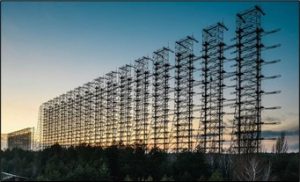
The Large Radar Array of an OTHR: Source-pinterest.com
As mentioned earlier, OTHR predominantly employs two techniques for EM wave propagation- Sky-Wave and Surface-Wave propagation.
In Sky-Wave propagation, HF radio signals are transmitted at an angle between 2º and 4º to the ionosphere. These signals get refracted towards the ground, beyond the radar horizon. When incident on a target of sufficient size up to distances as great as 3000-4000 Km, a portion of these signals then get reflected back to the ionosphere and return to the source via the same path. Due to relatively low frequencies (HF is one-tenth the value of VHF and one-hundredth the value of UHF), the transmitting and receiving apertures need to be phased arrays (a computer-controlled array of antennae to create a beam of radio waves that can be electronically steered to point in different directions without moving the antennae), extending one or more Km. These radars can also detect stealth-enabled aircraft/surface ships due to their large wavelengths, which defeat stealth shaping, thus making them an important component of counter-stealth operations. Since the exact transmission frequency will depend on the atmospheric conditions, this type of OTHR requires real-time monitoring of the reflected or backscattered signals to continuously adjust the transmission frequency. Such radars are called backscatter OTHR (OTH-B).
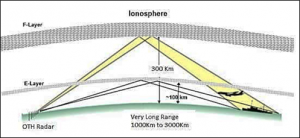
Schematic Depiction of Sky Wave OTH Radar (Ionospheric Reflection): Source-rfwireless-world.com
The other OTHR design refers to Surface-Wave OTHR, which largely operate from coastal regions for aerial/maritime surveillance. These systems utilise diffraction of transmitted/ received EM waves (bending of EM waves to ‘illuminate’ shadow areas) over the ocean’s surface. The water surface, like the ionosphere, acts as a conducting medium that allows diffraction. The transmitted signal thus follows the curve of the air-sea interface to detect targets beyond the visible horizon. Accuracy of these OTHR are relatively low in azimuth and distance, with detection ranges limited to about 300-500 Km, making them useful for detection of maritime targets/to cover the significant radar-shadow area of the Sky-Wave OTHR. The use of multistatic (separate antenna/ receiver arrays) OTHR since the 1990s have improved resolution, thus making Surface-Wave OTHR better equipped now for aerial target detection.
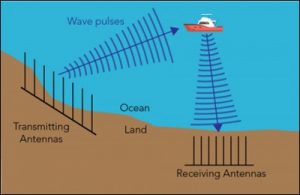
Schematic Depiction of Surface-Wave OTH Radar: Source- letstalkscience.ca
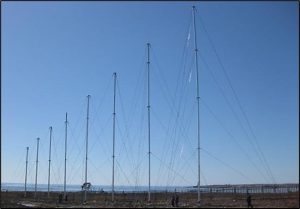
Raytheon Surface-Wave OTHR Array Deployed at Halifax, Nova Scotia , Canada: Source- letstalkscience.ca
Global Scan of OTH Radars
Currently, about eight countries in the world operate OTHR, with India on the threshold of developing one for maritime surveillance in the Indian Ocean region (IOR).
Apart from the TACMOR described above, the US have also deployed three variants of the Relocatable Sky-Wave OTHR (referring to the ability to relocate transmitters/receivers/operational control centers), predominantly in anti-drug trafficking role, to cover Central America, the Caribbean and South America. The USAF also maintains six East/West Coast OTH-B Radars in a state called ‘warm storage,’ which preserves the physical and electrical integrity of the system for re-operationalisation, if necessitated, which would take up to 24 months from the date of decision.
Russia installed the 29B6 ‘Kontayner’ Sky wave OTHR in Mordovia, Russia, which has been active since December 2013. The OTHR uses separate transmitter and receiver arrays 300 Km apart to monitor airspace West of Russia, the Mediterranean Sea and the Black Sea regions. An upgraded system is now in place. The ‘Podsolnukh-E’ Surface-Wave OTHR was developed in the early 2000s for detection of surface/aerial targets upto 450 Km. The OTHR can simultaneously track more than 300 surface/air targets including stealth-enabled platforms around the clock and in all weather conditions. It is deployed at three sites in the Sea of Okhotsk, the Sea of Japan, and the Caspian Sea. India has reportedly expressed interest in this OTHR, as stated by a representative of the OEM, State-owned Rosoboronexport JSC during the International Maritime Defense Show-2023, held from 21-25 June this year at Kronstadt (St. Petersburg), Russia.
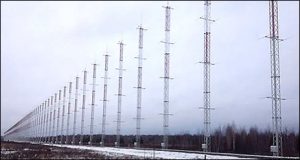
Kontayner Radar Array: Source-globalsecurity.org
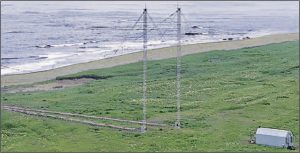
The Podsolnukh-E Surface-Wave OTHR: Source-roe.ru
China currently operates a number of Surface-Wave OTHR and OTH-B Radars. China may have purchased its first Sky-Wave OTHR from Russia in the early 2000s. Majorly, four Surface-Wave multistatic OTHR are operational in Zhejiang, Fujian and Guangdong Provinces, along China’s Eastern Seaboard, presumably for tracking activities in the South/East China Sea and the Western Pacific. The PLA Air Force (PLAAF) ‘Skywave Brigade’ located in Hubei Province in Central China, operates Sky-Wave OTH-B Radars. Their first indigenous OTH-B radar receiver was completed in June 2007, with the transmitter, located 100 Km to the Northeast of the receiver, being built subsequently. The radar looks at the East/South China Sea and the area up to Guam. Construction of the second OTH-B radar, likely deployed in Inner Mongolia, commenced in late 2016, to cover the entire Korean Peninsula and a large part of Japan, including airfields that operate the F-35 stealth fighters. China is also thought to have developed a compact, ship-based OTHR for surveillance over maritime traffic.
Australia developed the Jindalee Operational Radar Network in 2000. Operated by the Royal Australian Air Force, Jindalee is a multistatic OTH-B Radar, allowing it to have both long range as well as anti-stealth capabilities. The OTHR has detected Chinese ballistic missile launches at ranges greater than 5500 Km!
Canada deployed two SWR503 Surface-Wave OTHR at Cape Race and Cape Bonavista, Newfoundland in 1999 and operationalised them in 2002. In 2010, a 3rd Generation Surface-Wave OTHR with improved range/accuracy and ‘sense-and-adapt’ technology to avoid spectrum interference with commercial users was developed. In 2019, Canadian manufacturer MAEROSPACE was granted a global license to design, manufacture and market this improved OTHR.
France developed the Nostradamus Sky-Wave OTHR, which in the spring of 1999, famously detected two Northop Grumman B2 Spirit strategic stealth bombers over Kosovo. The OTHR was operationalized in 2005 and is presently in service. In 2015, a Surface-Wave OTHR with a range of 370 Km, developed by the French Stradivarius Research Project was operationalised on France’s Mediterranean Coast.
Iran has reportedly developed a Sky-Wave OTHR called Sepehr. The radar is reported to be operational. Brazil has developed a Surface-Wave OTHR, OTH 0100, with a range of 370 Km for detection of maritime targets.
India’s Strides in OTHR
DRDO’s Electronics & Radar Development Establishment (LRDE) has designed and is currently developing a prototype OTHR. The radar is to be deployed on India’s Western Seaboard for surveillance/ detection in the Indian Ocean Region. The radar prototype is to have two different types of radar arrays – a log-periodic wire antenna (LPWA) array and a broadband monopole antenna array. The LPWA will probably perform the role of backscatter receiver to continuously determine the best transmission frequency. The monopole antenna array will consist of 32 elements. The initial prototype of this OTHR would be a Surface-Wave OTHR with a range of approximately 500 Km. This would be followed by a Sky-Wave OTHR with a detection range of about 2000 Km. These radars would have application in all three Services of the Armed Forces.
Conclusion
In a time when speeds and ranges of target acquisition, detection and engagement have greatly cut down reaction times, it is imperative that an adversary’s long-range combat platforms are detected as early and as far out as possible. Use of OTHR would enhance situational awareness over larger swathes of territory and enable timely cueing of vectors to thwart even BRH misadventures by an adversary.
Disclaimer
The opinions expressed in this article are the author’s own and do not reflect the views of Chanakya Forum. All information provided in this article including timeliness, completeness, accuracy, suitability or validity of information referenced therein, is the sole responsibility of the author. www.chanakyaforum.com does not assume any responsibility for the same.
Chanakya Forum is now on . Click here to join our channel (@ChanakyaForum) and stay updated with the latest headlines and articles.
Important
We work round the clock to bring you the finest articles and updates from around the world. There is a team that works tirelessly to ensure that you have a seamless reading experience. But all this costs money. Please support us so that we keep doing what we do best. Happy Reading
Support Us







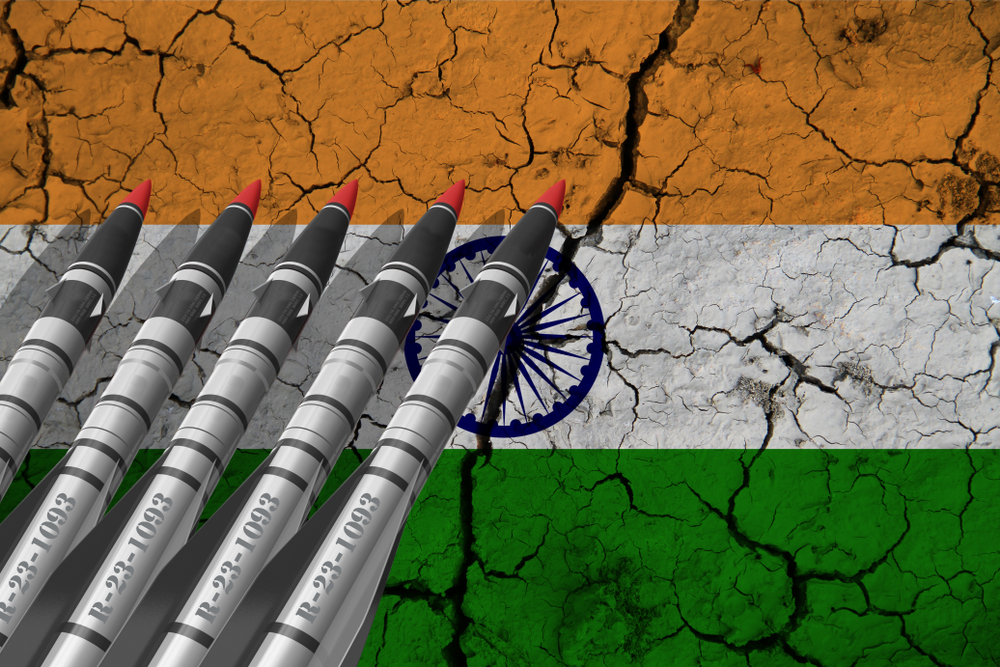

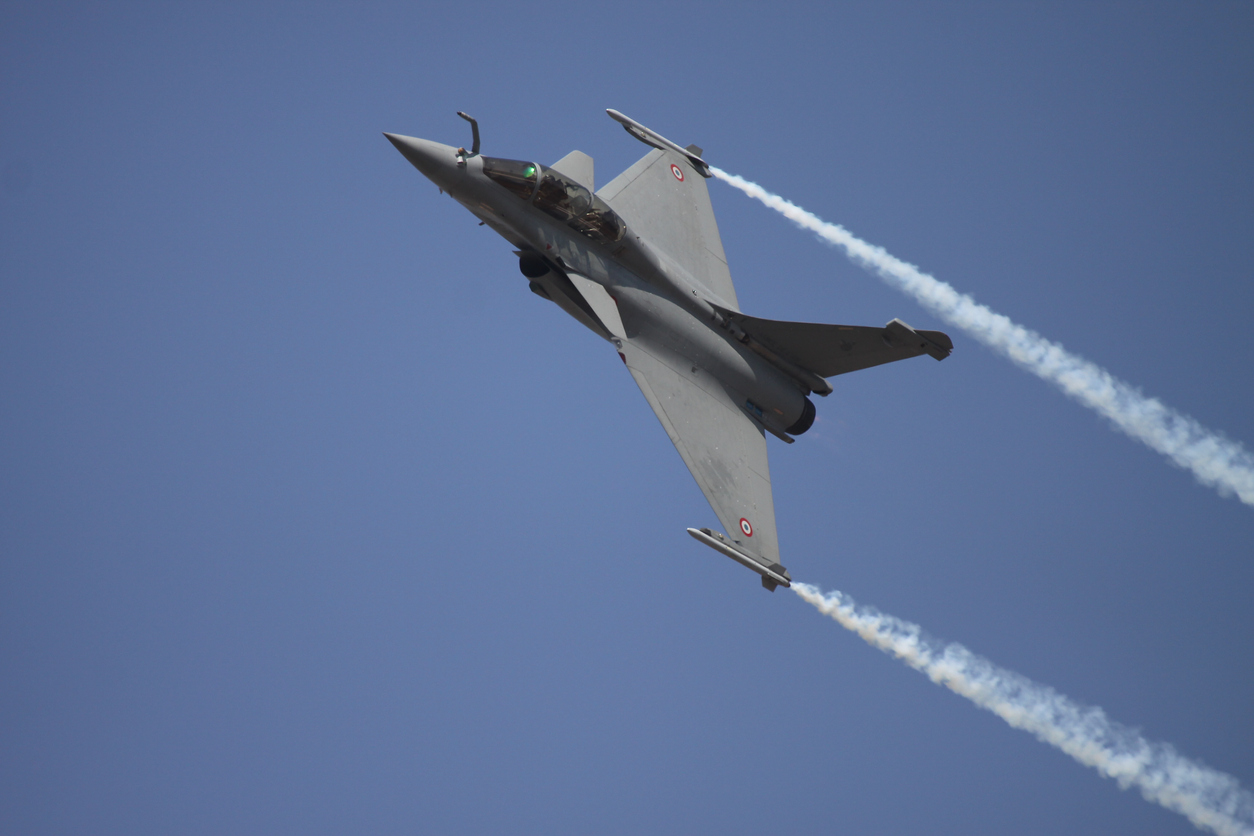
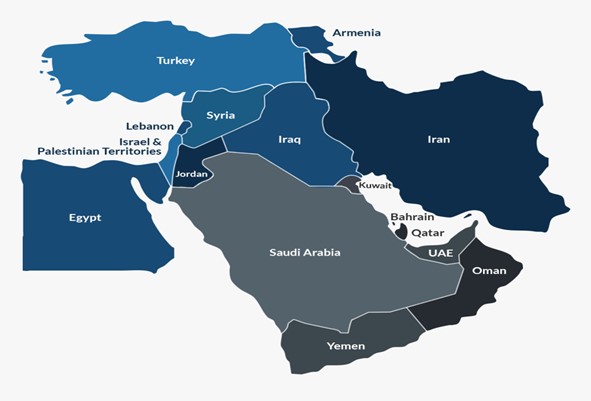


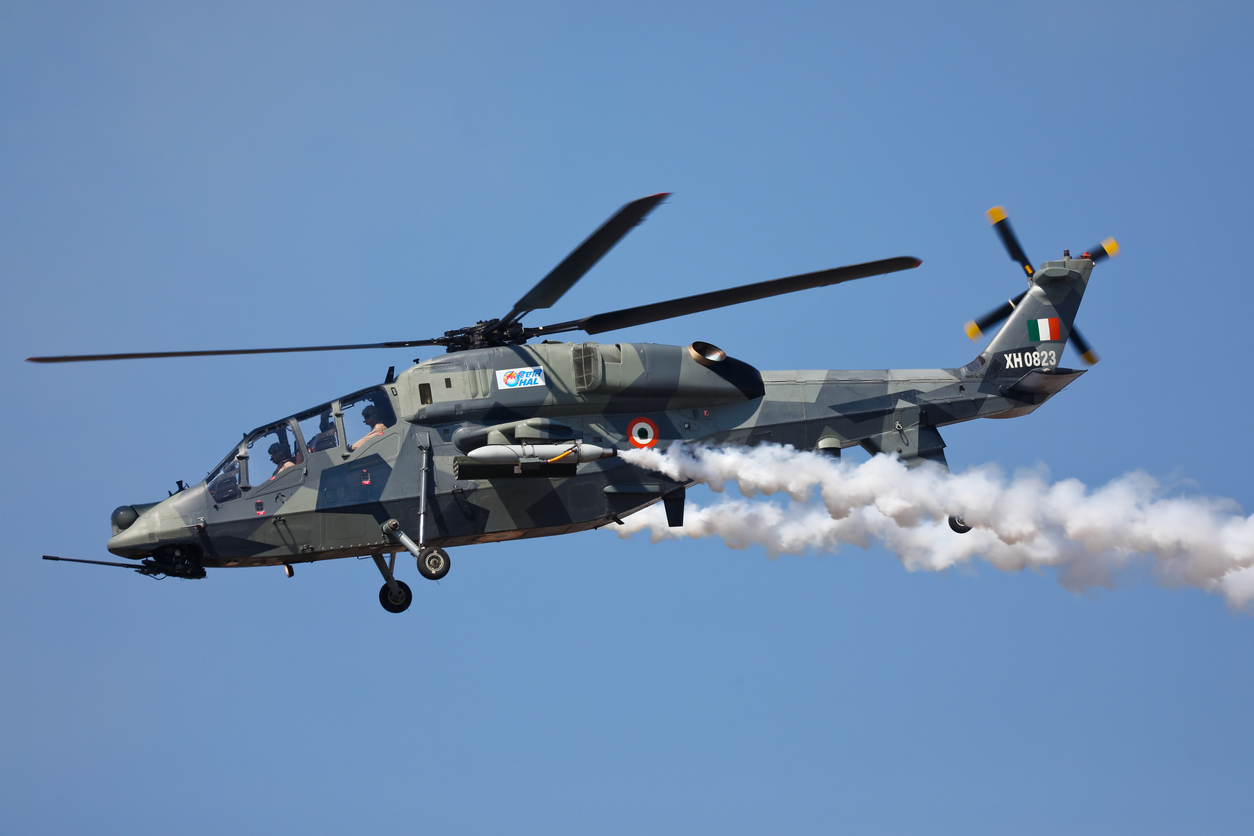







POST COMMENTS (1)
rada